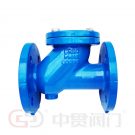Ball Check Valve
Its working principle is as follows: The rubber ball rolls a short distance within the ball cover to achieve the opening and closing of the valve. When the pump starts, water under pressure pushes the rubber ball, causing it to roll to the right side and be fixed in position by the cone body in the rear valve body, thereby opening the check valve. After the pump stops, the backflow pressure in the pipeline system forces the rubber ball to roll to the left side of the front valve body, achieving the closure of the check valve. The hollow steel ball, externally covered with highly elastic rubber, ensures both sealing and minimizes damage to the pipeline system during valve closure. The conical body with holes fixes the steel ball and eliminates pressure on the contact area between the rubber ball and the cone body when the valve opens, resulting in surface contact and reducing hydraulic losses caused by the vibration of the rubber ball inside the valve body.





